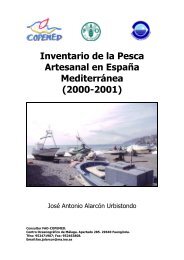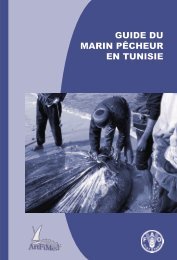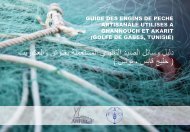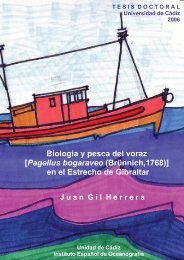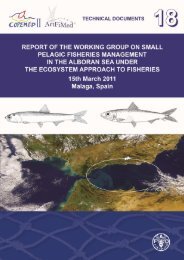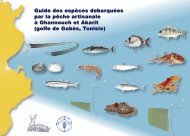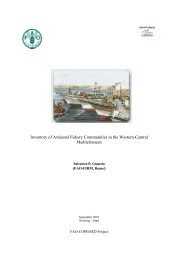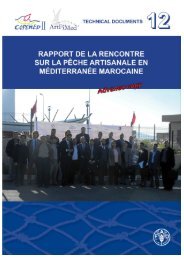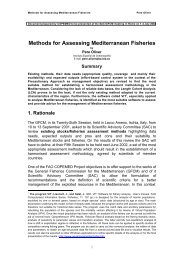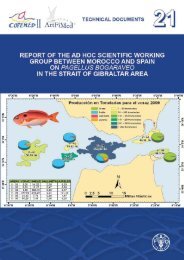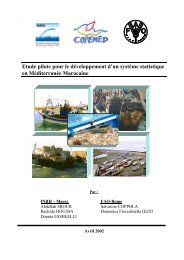Cours sur les méthodes d'évaluation acoustique ... - Fao - Copemed
Cours sur les méthodes d'évaluation acoustique ... - Fao - Copemed
Cours sur les méthodes d'évaluation acoustique ... - Fao - Copemed
You also want an ePaper? Increase the reach of your titles
YUMPU automatically turns print PDFs into web optimized ePapers that Google loves.
The NMEA 0183 Protocol 22. Electrical InterfaceNMEA 0183 devices are designated as either talkers or listeners (with some devices being both),employing an asynchronous serial interface with the following parameters:Baud rate: 4800Number of data bits: 8 (bit 7 is 0)Stop bits:1 (or more)Parity:noneHandshake:noneNMEA 0183 allows a single talker and several listeners on one circuit. The recommended interconnectwiring is a shielded twisted pair, with the shield grounded only at the talker. The standard dos not specifythe use of a particular connector. Note: The new 0183-HS standard (HS = high speed) introduced inversion 3.0 uses a 3-wire interface and a baud rate of 38400. This type of interface is not discussed here.Its is recommended that the talker output comply with EIA RS-422, a differential system with two signallines, "A" and "B". Differential drive signals have no reference to ground and are more immune to noise.However, a single-ended line at TTL level is accepted as well. The voltages on the A line correspond tothose on the TTL single wire, while the B voltages are inverted (when output A is at +5 V, output B is at0 V, and vice versa. This is the unipolar RS-422 operation. In bipolar mode ±5 V are used).In either case, the recommended receive circuit uses an opto-isolator with suitable protection circuitry.The input should be isolated from the receiver's ground. In practice, the single wire, or the RS-422 "A"wire may be directly connected to a computer's RS-232 input. In fact even many of the latest products,like hand-held GPS receivers, do not have a RS-422 differential output, but just a single line with TTL or5 V CMOS compatible signal level.3. General Sentence FormatAll data is transmitted in the form of sentences . Only printable ASCII characters are allowed, plus CR(carriage return) and LF (line feed). Each sentence starts with a "$" sign and ends with . Thereare three basic kinds of sentences: talker sentences , proprietary sentences and query sentences.Talker Sentence s. The general format for a talker sentence is:$ttsss,d1,d2,....The first two letters following the „$” are the talker identifier. The next three characters (sss) are thesentence identifier, followed by a number of data fields separated by commas, followed by an optionalchecksum, and terminated by carriage return/line feed. The data fields are uniquely defined for eachsentence type. An example talker sentence is:$HCHDM,238,Mwhere "HC" specifies the talker as being a magnetic compass, the "HDM" specifies the magnetic headingmessage follows. The "238" is the heading value, and "M" designates the heading value as magnetic.A sentence may contain up to 80 characters plus "$" and CR/LF. If data for a field is not available, thefield is omitted, but the delimiting commas are still sent, with no space between them. The checksumfield consists of a "*" and two hex digits representing the exclusive OR of all characters between, but notincluding, the "$" and "*".Proprietary Sentence s. The standard allows individual manufacturers to define proprietary sentenceformats. These sentences start with "$P", then a 3 letter manufacturer ID, followed by whatever data themanufacturer wishes, following the general format of the standard sentences. Some proprietarysentences, mainly from Garmin, Inc., are listed in chapter 6.




